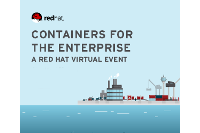The Friday Five is a weekly Red Hat® blog post with 5 of the week's top news items and ideas from or about
Red Hat and the technology industry. Consider it your weekly digest of things that caught our eye.


CHECK IT OUT:
Registration for 2017 Red Hat Summit is open
Registration is now open for the 2017 Red Hat Summit! Learn, network, and experience open source at every level with hundreds of sessions led by the best and brightest in open source, hands-on experience with our newest technologies, face-to-face interaction with product experts–or the actual builders–demonstrating the latest technologies, the chance to grow your network, reconnect with peers, and make new partnerships. The event will be in Boston at the Boston Convention and Exhibition Center, May 2-4, 2017. Early bird registration ends March 2.


CHECK IT OUT:
Containers for the Enterprise - A Red Hat virtual event
Now more than ever, we know that modern application development and deployment are tied to business growth. A business is 8 times more likely to gain share if it is at the forefront of digital maturity. Speed, security, and operational efficiency are key elements that will determine success or failure. Linux® containers, used correctly, will help your organization deliver all three. Sign up and attend Containers for the Enterprise | A Red Hat virtual event to find out how to unlock the potential of Linux containers in their enterprise. The live event will take place Thursday, January 19, 2017 at 11 a.m. ET | 4 p.m. UTC.


IN THE NEWS:
CRN - The 10 Coolest Open Source Products Of 2016
In 2016, open source products were front-and-center. A number of new offerings in containers, networking, storage and other major areas were among those that debuted during the year. At #4 is Red Hat Ceph Storage 2. Red Hat this year unveiled a major update to Ceph Storage, the company's open software-defined storage platform — the first new version of the platform since Red Hat acquired the technology in 2014. Ceph Storage 2 introduces a new storage management system and new features geared toward object storage workloads, such as new global object storage clusters that offer better data synchronization between distributed clusters and other benefits.


GOOD READ:
Red Hat Enterprise Linux blog - Five Reasons to Switch from vSphere to Red Hat Virtualization
It's time to upgrade or to renew your VMware vSphere licenses. This decision is not easy for a few reasons such as: One or more of your VMware products are end of life, or there are hundreds or thousands of virtual machines (VMs) in your environment and the costs to maintain them has significantly gone up. I have good news for you. There is a reliable and enterprise choice and switching has never been easier with the recent release of Red Hat Virtualization 4. You can run Red Hat Virtualization alongside VMware and migrate workloads in phases, perhaps starting with dev/test. Compared to competing products, Red Hat Virtualization delivers easier integration and interoperability with existing infrastructure, higher density and performance, and improved economics. Read more on the 5 reasons you should switch to Red Hat Virtualization.


RECOMMENDED READING:
The FOSS Post - Insights on Red Hat, SUSE & Canonical; The Major Linux Companies
Today, the Linux operating system is used almost everywhere, from web servers, android devices, supercomputers and to IoT devices. Linux has become more than just an operating system, and because of this, it has created huge opportunities for enterprises to benefit from. This market allowed great tech companies to be established to fulfill its needs, which gave us the 3 major Linux companies: Red Hat, SUSE and Canonical. The business model for each of the major companies was similar: selling support services and subscriptions for their own open source and Linux-based products. Since its establishment in 1993, Red Hat grown to become the biggest Linux and open source company and a key player in the open source world. Red Hat offers a lot of solutions and services, however, Red Hat also provides a lot more than products and technologies. Red Hat certifications are one of the most valuable certifications in the Linux market. If you are planning to get a career in this field, you definitely should look into the RHCSA (Red Hat Certified System Administrator) or RHCE (Red Hat Certified Engineer) courses. According to Red Hat, more than 90% of the top 500 fortune global companies rely on them for their infrastructure. The company is expecting a total revenue of around $2.4 billion for the fiscal year 2017 (which will end in February, 2017). Thus, making it–fairly–the largest open source company in the world.
Sobre el autor
Red Hat is the world’s leading provider of enterprise open source solutions, using a community-powered approach to deliver high-performing Linux, cloud, container, and Kubernetes technologies.
Más similar
Navegar por canal
Automatización
Las últimas novedades en la automatización de la TI para los equipos, la tecnología y los entornos
Inteligencia artificial
Descubra las actualizaciones en las plataformas que permiten a los clientes ejecutar cargas de trabajo de inteligecia artificial en cualquier lugar
Nube híbrida abierta
Vea como construimos un futuro flexible con la nube híbrida
Seguridad
Vea las últimas novedades sobre cómo reducimos los riesgos en entornos y tecnologías
Edge computing
Conozca las actualizaciones en las plataformas que simplifican las operaciones en el edge
Infraestructura
Vea las últimas novedades sobre la plataforma Linux empresarial líder en el mundo
Aplicaciones
Conozca nuestras soluciones para abordar los desafíos más complejos de las aplicaciones
Programas originales
Vea historias divertidas de creadores y líderes en tecnología empresarial
Productos
- Red Hat Enterprise Linux
- Red Hat OpenShift
- Red Hat Ansible Automation Platform
- Servicios de nube
- Ver todos los productos
Herramientas
- Training y Certificación
- Mi cuenta
- Soporte al cliente
- Recursos para desarrolladores
- Busque un partner
- Red Hat Ecosystem Catalog
- Calculador de valor Red Hat
- Documentación
Realice pruebas, compras y ventas
Comunicarse
- Comuníquese con la oficina de ventas
- Comuníquese con el servicio al cliente
- Comuníquese con Red Hat Training
- Redes sociales
Acerca de Red Hat
Somos el proveedor líder a nivel mundial de soluciones empresariales de código abierto, incluyendo Linux, cloud, contenedores y Kubernetes. Ofrecemos soluciones reforzadas, las cuales permiten que las empresas trabajen en distintas plataformas y entornos con facilidad, desde el centro de datos principal hasta el extremo de la red.
Seleccionar idioma
Red Hat legal and privacy links
- Acerca de Red Hat
- Oportunidades de empleo
- Eventos
- Sedes
- Póngase en contacto con Red Hat
- Blog de Red Hat
- Diversidad, igualdad e inclusión
- Cool Stuff Store
- Red Hat Summit

